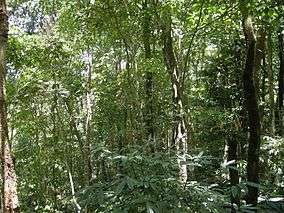Dampa Tiger Reserve
| Dampa Tiger Reserve | |
|---|---|
|
IUCN category II (national park) | |
|
Dampa Tiger Reserve Forest | |
  Dampa Tiger Reserve | |
| Location | Mizoram, India |
| Nearest city | Aizawl |
| Coordinates | 23°34′N 92°22′E / 23.567°N 92.367°ECoordinates: 23°34′N 92°22′E / 23.567°N 92.367°E |
| Area | 550 square kilometres (210 sq mi) |
| Established | 1985 |
| Visitors | NA |
| Governing body | Ministry of Environment and Forests, Government of India |
Dampa Tiger Reserve or Dampha Tiger Reserve, the largest [1] wildlife sanctuary in Mizoram, was notified in 1985 and declared a Tiger Reserve in 1994. It is situated in the western part of Mizoram state, at the international border with Bangladesh about 127 km from Aizawl. It covers an area of approximately 550 km².[2] The tropical forests of Dampa are home to rich flora and fauna. It consists of forest interpolated with steep precipitous hills, deep valleys, jungle streams, ripping rivulets, natural salts licks, with an altitudinal zone of 200–800 mts. Dampa Tiger Reserve is a part of Project Tiger funded by the Government of India.[3]
Etymology
Dampa Tiger Reserve consists of Dampa hills, Pathlawi Lunglen hill, Chhawrpial Hills and many others. It is called Dampa because a long time back there used to be a village called Dampa where a lot of the womenfolk died, hence a lot of lonely bachelors were left behind, hence the name "Dam pa" or "lonely Men".[4]
Administration
Jurisdiction is under two ranges, namely Teirei Range leh Phuldungsei Range. Workers consist of a Field Director who is headquartered in W. Phaileng. There are also about five foresters and 10 regular forest guards.
Forest and Wildlife
Dampa Tiger Reserve is the natural home of leopards, Indian bison, barking deer, sloth bear, gibbons, langurs, slow loris, rhesus macaque, Indian Python(Python Molurus Molurus), wild boar and a variety of birds.[5] Unfortunately its namesake tiger has disappeared almost entirely, the enumeration indicated only 4 individuals in 1994, when it was pronounced as a tiger reserve. None were seen again. However, Aaranyak, a society for biodiversity conservation at Guwahati, and WWF India analysed faecal sample in March 2012 using DNA fingerprinting, and announced the genetic evidence of tiger presence in the reserve. The result showed that out of 27 scats collected, 9 were of tiger origin and work is continued to find out the number of individual tigers.[6][7] It has been reported that there has been an increase in built up (590%), bamboo forest (192.89%) and scrub (74.67%) areas. These increases are simultaneously accompanied by decrease in cover area of evergreen/semi evergreen closed forests from 152.47 km2 in 1978 to 95.27 km2 in 2005. This could be due to the practice of shifting cultivation by villagers at the border of the reserve.[8] A 62-km fence and patrol road along the Bangladesh boundary near the reserve in Mizoram is being constructed despite concerns on the impact of animal movements.[9]
See also
- List of Protected areas in India
- Protected areas of India
- National parks of India
- Reserved forests and protected forests of India
References
- ↑ "Dampa Wildlife". Mizoram Tourism. Retrieved 20 August 2012.
- ↑ "Mizoram Tourism - Dampa Tiger Reserve". Retrieved 2011-06-26.
- ↑ "Tiger Reserve Guide". Project Tiger. Retrieved 20 August 2012.
- ↑ B. Ramdinliana. "Dampa Tiger Reserve hi". Vanglaini. Retrieved 20 August 2012.
- ↑ Visit North East. "Dampa Tiger Reserve". visitnortheast.com. Retrieved 2013-06-24.
- ↑ "Big cat hope rises in Dampa reserve". Telegraph India. Calcutta, India. 26 April 2012. Retrieved 20 August 2012.
- ↑ "Tiger presence in Mizoram forest area confirmed". rediff.com. 25 April 2012. Retrieved 2013-06-24.
- ↑ Devi HS, Hmingthanpuii, Sarma KK (2011). "Change in vegetation cover of Dampa Tiger Reserve, Mizoram, North East India: A serious threat to tiger population". Journal of Experimental Sciences. 2 (9): 1–6. Retrieved 25 June 2013.
- ↑ Goswami, Roopak (11 May 2011). "Nod to border fence near tiger reserve". Telegraph India. Calcutta, India. Retrieved 20 August 2012.
- Report of Dampa
- Raman T. R. S.; Rawat G. S.; Johnsingh A. J. T. (1998). "Recovery of tropical rainforest avifauna in relation to vegetation succession following shifting cultivation in Mizoram, northeast India". Journal of Applied Ecology. 35: 214–231. doi:10.1046/j.1365-2664.1998.00297.x.
